    
10/3: •HerBelMeyerAubBoe – RoBeetWeHayMo•:
Ducommun Girod N° 7777, 6 Timbres
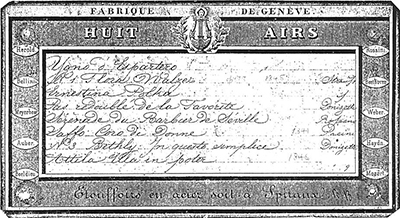
Presumably Pattern 30725
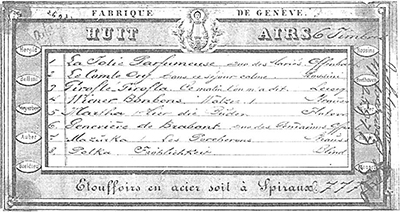
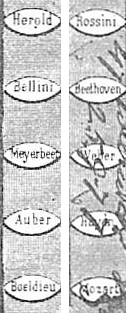
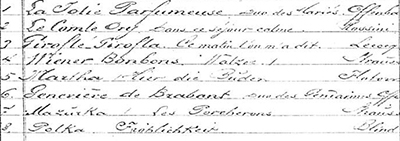

Nummer 7777

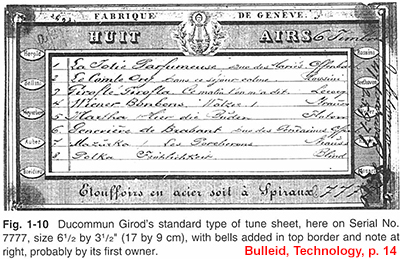
Fig. 1-10 shows the tune sheet for Serial No. 7777, with „6 timbres“ rather casually added in the top border. Tune No. 3 is the latest, 1874, but run close by Tune No. 1 whose premiere was on Nov. 29, 1873. The business closed in 1874 so this must have been among the last of the Ducommun Girod boxes. The note dated 25. 9. [18]77 in the right border suggests it was first sold in London on that date – a delay in selling was to be expected at that time because stocks were high in London. (Bulleid: Cylinder Musical Box Technology, 1994, p. 14-17)
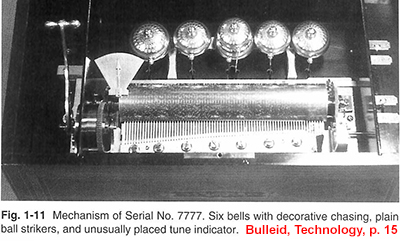
The mechanism of Serial No. 7777 is shown in fig. 1-11. It has a 10 3/3“ (27 cm) cylinder playing eight airs on a 70-tooth comb, with separate six-tooth comb for the bells. The a teeth (44OHz) are Nos. 18 and 19, with relative stiffness 250. The teeth are numbered 1 to 7 in each octave on the brass comb base, the semitones having their numbers stamped sideways.
Blank code 0 is stamped on the bedplate edge and great wheel and scribed on end caps and governor. Blank code 6 is scribed on the winder, spring cover, and governor and scribed on the tune indicator. Gear ratio, endless-to-cylinder, is 1664 to 1. It is a conventional 1875-period six-bell movement except for the limited blank code numbers and tune indicator which is oddly placed and disconcertingly close to the cylinder pins.
The case is longer, wider and deeper than strictly necessary but looks good with stringing plus banding on front, sides and domed lid and marquetry on lid and front.
The bedplate is mounted on two blocks fixed in the case below by 2“ (5 cm) round-head wood screws which pass through iron straps, fully two inchs wide, under the case. Heavy engineering! The control levers are rather spindly brass castings. Their tops are twisted 90 degrees for improves finger contact. The offset tune change lever, with central position marked with a double line, is a strange complication. It increases the spacing between the two levers, but to no advantage. As seen in Fig. 1-11 the engraved brass labels for the control levers are set right angles to the usual position. Sometimes Ducommun Girod, like some other makers, simply omitted them.
The performance is well up to normal 1875 standards except that the cylinder is pinned to play at 0.12“ (3 mm) per second so tunes last only 52 seconds. They are well arranged, but there is no piccolo emphasis which at one time was a Ducommun Girod feature. The bells are very nicely used and more than make up, particularly if you have recently heard a a powerful piccolo performance.
(Bulleid: Cylinder Musical Box Technology, 1994, p. 14-17)
Zur Sitemap Spielwerke der Firma Ducommun Girod
10/3: •HerBelMeyerAubBoe – RoBeetWeHayMo•:
Ducommun Girod N° 7777, 6 Timbres
    
|






